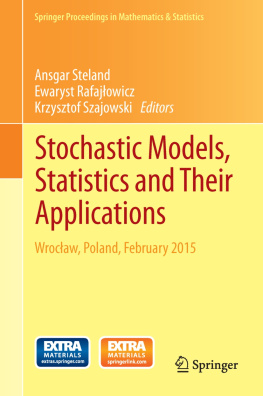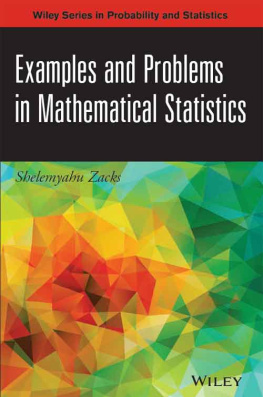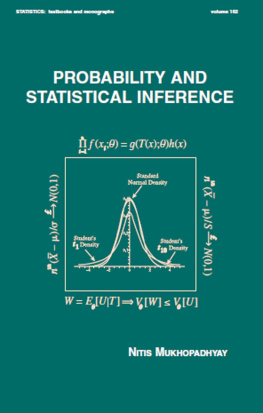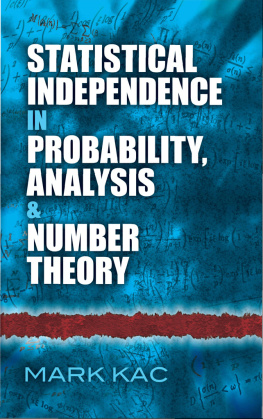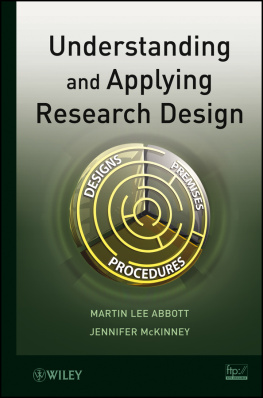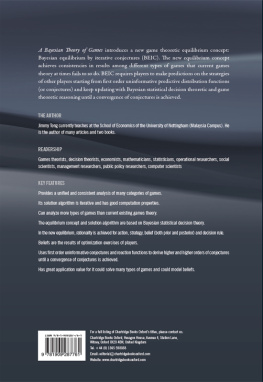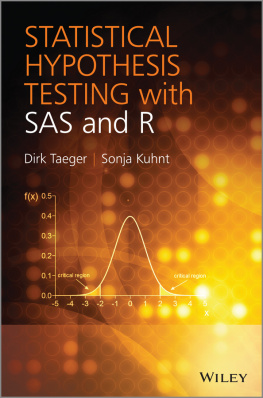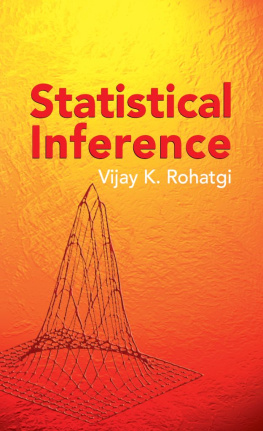SEQUENTIAL
ANALYSIS
ABRAHAM WALD
Late Professor of Mathematical Statistics
Columbia University
DOVER PUBLICATIONS, INC.
Mineola, New York
DOVER PHOENIX EDITIONS
Copyright
Copyright 1947 by Abraham Wald
Bibliographical Note
This Dover edition, first published in 1973 and reprinted in 2004, is an unabridged and unaltered republication of the work originally published by John Wiley & Sons, Inc., in 1947.
International Standard Book Number
eISBN-13: 978-0-486-61579-0
Manufactured in the United States by Courier Corporation
61579001 2013
www.doverpublications.com
PREFACE
This book presents the theory of a recently developed method of statistical inference, that of sequential analysis. An effort has been made to keep the exposition on a level that will make most of the book, with the exception of the Appendix, understandable to readers whose mathematical background does not go beyond college algebra and a first course in calculus. Some knowledge of probability and statistics is desirable for the understanding of the book, although not essential, for a brief review is given of the fundamental concepts, such as random variables, probability distributions, and statistical hypotheses.
To facilitate the reading of the book for those who have no advanced mathematical training, some concessions are made to generality and occasionally even to rigor. Furthermore, mathematical derivations of somewhat intricate nature are put into the Appendix, the reading of which may be omitted without impairing the understanding of the rest of the book.
This book contains an expanded exposition of the ideas and results I published in two technical papers on this subject, one of which appeared in 1944 and the other in 1945, as well as some further developments. Such developments, for example, are: the discussion of multivalued decisions and estimation in Part III; improvements in the limits for the average number of observations required by a sequential test; and limits for the effect of grouping in the binomial case. Some recent results of M. A. Girshick are included and, in the discussion of certain applications in Part II, use is made of some simplifications contained in a publication of the Statistical Research Group of Columbia University dealing with these applications.
Nearly all tables in the book were computed by the Statistical Research Group of Columbia University while I was a consultant to the group. A few sections of my two forementioned publications have been incorporated in this book, mostly in the Appendix, without substantial changes.
I wish to express my indebtedness to Milton Friedman and W. Allen Wallis, who proposed the problem of sequential analysis to me in March, 1943. It was their clear formulation of the problem that gave me the incentive to start the investigations leading to the present developments. I also wish to express my thanks to the Social Science Research Council for their help, which facilitated the publication of this book. I am indebted to Mr. Mortimer Spiegelman of the Metropolitan Life Insurance Company for his careful reading of the manuscript and for making several valuable suggestions. Thanks are due also to Mrs. E. Bowker who prepared the manuscript with particular care.
A. W
Columbia University
March, 1947
CONTENTS
INTRODUCTION
Sequential analysis is a method of statistical inference whose characteristic feature is that the number of observations required by the procedure is not determined in advance of the experiment. The decision to terminate the experiment depends, at each stage, on the results of the observations previously made. A merit of the sequential method, as applied to testing statistical hypotheses, is that test procedures can be constructed which require, on the average, a substantially smaller number of observations than equally reliable test procedures based on a predetermined number of observations.
This book presents the theory of a particular method of sequential analysis, the so-called sequential probability ratio test, which was devised by the author in 1943 mainly for the purpose of testing statistical hypotheses. A comparison of this particular sequential test procedure with any other (sequential or non-sequential) is shown, in , to effect the greatest possible saving in the average number of observations, when used for testing a simple hypothesis against a single alternative. The sequential probability ratio test frequently results in a saving of about 50 per cent in the number of observations over the most efficient test procedure based on a fixed number of observations.
The first idea of a sequential test procedure, i.e., a test for which the number of observations is not determined in advance but is dependent on the outcome of the observations as they are made, goes back to H. F. Dodge and H. G. Romig sampling method, and Bartky his multiple sampling scheme was, of course, the recognition of the fact that they require, on the average, a smaller number of observations than single sampling.
The occasional practice of designing a large scale experiment in successive stages may be regarded as a forerunner of sequential analysis. The idea of such chain experiments was briefly discussed by Harold Hotelling. Sample censuses, steadily increasing in size, were taken primarily for the purpose of obtaining preliminary information about the parameters to be estimated. This information was then used for designing the final sampling of the whole immense jute area in Bengal.
The problem of sequential analysis arose in the Statistical Research Group of Columbia University Friedman and Wallis also exhibited a few examples of sequential modifications of current test procedures resulting, in some cases, in an increase of efficiency. It was at this stage that they proposed the problem of sequential analysis to the author. This gave the incentive for the authors investigations which then led to the development of the sequential probability ratio test.
Further advances in the theory of the sequential probability ratio test were made in 1944. The operating characteristic (OC) curve of the sequential probability ratio test for the case of a binomial distribution was found by Milton Friedman and George W. Brown (independently of each other), and slightly earlier by C. M. Stockman in England. which gives not only the OC curve of any sequential probability ratio test but also the characteristic function of the number of observations required by the test and various other results.
The material in the authors report together with the new advances made in 1944 were published by him in a paper, Sequential Tests of Statistical Hypotheses, in The Annals of Mathematical Statistics, June, 1945. The Statistical Research Group issued a revised edition original report. The revised edition includes a discussion of the operating characteristic and average sample number curves for various applications of the sequential probability ratio test.
Independently of the development in this country and about the same time, G. A. Barnard recognized the merits of a sequential method of testing. He treated the problem of double dichotomies, using a sequential method of testing which, however, differs from the one that results from the application of the sequential probability ratio test.
This book consists of three parts and an Appendix. Part I contains a discussion of the general theory of the sequential probability ratio test. Part II discusses applications of the general theory given in Part I. These applications are given primarily to illustrate the general theory and to bring out some points of theoretical interest which are specific to these applications. Accordingly, computational simplifications are not stressed much and hardly any tables are given. Part III outlines briefly a possible approach to the problem of sequential multi-valued decisions and estimation. This field is largely unexplored and further progress is still a matter of future developments. To facilitate the use of the book by readers with no advanced mathematical training, mathematical derivations of somewhat intricate nature are included in the Appendix.
Next page

